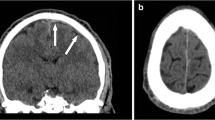Abstract
The purpose of this pictorial essay is to review the benefits of spiral head computed tomography (CT) with routine multiplanar reformations in the evaluation of acute intracranial pathology. This technique is particularly useful in trauma patients for detection of skull base or calvarial fractures, thin tentorial subdural hematomas, or for more specific characterization of intracranial hemorrhage. The benefits of multiplanar reformations have been described for a variety of other diagnoses in the chest, abdomen, extremities, and spine, and their routine use continues to grow with the widespread availability of multi-slice CT scanners. In this article, we describe spiral head CT technique with multiplanar reformations as an alternative to the routinely used sequential technique. Subtle findings and lesions aligned predominantly in the axial plane can often be visualized to better advantage with multiplanar reformations. We also address technical factors for optimizing spiral technique.




















Similar content being viewed by others
References
Haydel MJ, Preston CA, Mills TJ, Luber S, Blaudeau E, DeBlieux PM (2000) Indications for computed tomography in patients with minor head injury. N Engl J Med 343:100–105
Cassidy JD, Carroll LJ, Peloso PM et al (2004) Incidence, risk factors and prevention of mild traumatic brain injury: results of the WHO collaborating centre task force on mild traumatic brain injury. J Rehabil Med (43 Suppl):28–60
Aschoff AJ (2006) MDCT of the abdomen. Eur Radiol 16(Suppl 7):M54–M57
Fanucci E, Fiaschetti V, Rotili A, Floris R, Simonetti G (2007) Whole body 16-row multislice CT in emergency room: effects of different protocols on scanning time, image quality and radiation exposure. Emerg Radiol 13:251–257
Jaffe TA, Martin LC, Thomas J, Adamson AR, DeLong DM, Paulson EK (2006) Small-bowel obstruction: coronal reformations from isotropic voxels at 16-section multi-detector row CT. Radiology 238:135–142
Jayashankar A, Udayasankar U, Sebastian S, Lee EK, Kalra M, Small W (2008) MDCT of thoraco-abdominal trauma: an evaluation of the success and limitations of primary interpretation using multiplanar reformatted images vs axial images. Emerg Radiol 15:29–34
Kim HC, Yang DM, Jin W (2008) Identification of the normal appendix in healthy adults by 64-slice MDCT: the value of adding coronal reformation images. Br J Radiol 81:859–864
Lucey BC, Stuhlfaut JW, Hochberg AR, Varghese JC, Soto JA (2005) Evaluation of blunt abdominal trauma using PACS-based 2D and 3D MDCT reformations of the lumbar spine and pelvis. AJR Am J Roentgenol 185:1435–1440
Mirvis SE, Shanmuganagthan K (2007) Imaging hemidiaphragmatic injury. Eur Radiol 17:1411–1421
Zangos S, Steenburg SD, Phillips KD et al (2007) Acute abdomen: added diagnostic value of coronal reformations with 64-slice multidetector row computed tomography. Acad Radiol 14:19–27
Sliker CW (2008) Blunt cerebrovascular injuries: imaging with multidetector CT angiography. Radiographics 28:1689–1708, discussion 1709–1610
Hernalsteen D, Cosnard G, Robert A, Grandin C, Vlassenbroek A, Duprez T (2007) Suitability of helical multislice acquisition technique for routine unenhanced brain CT: an image quality study using a 16-row detector configuration. Eur Radiol 17:975–982
Ptak T, Rhea JT, Novelline RA (2003) Radiation dose is reduced with a single-pass whole-body multi-detector row CT trauma protocol compared with a conventional segmented method: initial experience. Radiology 229:902–905
Wei SC, Ulmer S, Lev MH, Pomerantz SR, Gonzalez RG, Henson JW (2010) Value of coronal reformations in the CT evaluation of acute head trauma. AJNR Am J Neuroradiol 31:334–339
Zacharia TT, Nguyen DT (2009) Subtle pathology detection with multidetector row coronal and sagittal CT reformations in acute head trauma. Emerg Radiol 17:97–102
Depreitere B, Van Lierde C, Sloten JV et al (2006) Mechanics of acute subdural hematomas resulting from bridging vein rupture. J Neurosurg 104:950–956
Servadei F, Murray GD, Teasdale GM et al (2002) Traumatic subarachnoid hemorrhage: demographic and clinical study of 750 patients from the European brain injury consortium survey of head injuries. Neurosurgery 50:261–267, discussion 267–269
Gentry LR (1994) Imaging of closed head injury. Radiology 191:1–17
Mattioli C, Beretta L, Gerevini S et al (2003) Traumatic subarachnoid hemorrhage on the computerized tomography scan obtained at admission: a multicenter assessment of the accuracy of diagnosis and the potential impact on patient outcome. J Neurosurg 98:37–42
Strub WM, Leach JL, Tomsick T, Vagal A (2007) Overnight preliminary head CT interpretations provided by residents: locations of misidentified intracranial hemorrhage. AJNR Am J Neuroradiol 28:1679–1682
Laine FJ, Shedden AI, Dunn MM, Ghatak NR (1995) Acquired intracranial herniations: MR imaging findings. AJR Am J Roentgenol 165:967–973
New PF, Aronow S, Hesselink JR (1980) National Cancer Institute study: evaluation of computed tomography in the diagnosis of intracranial neoplasms. IV. Meningiomas. Radiology 136:665–675
Smirniotopoulos JG, Murphy FM, Rushing EJ, Rees JH, Schroeder JW (2007) Patterns of contrast enhancement in the brain and meninges. Radiographics 27:525–551
Hofman PA, Nelemans P, Kemerink GJ, Wilmink JT (2000) Value of radiological diagnosis of skull fracture in the management of mild head injury: meta-analysis. J Neurol Neurosurg Psychiatry 68:416–422
Turner BG, Rhea JT, Thrall JH, Small AB, Novelline RA (2004) Trends in the use of CT and radiography in the evaluation of facial trauma, 1992–2002: implications for current costs. AJR Am J Roentgenol 183:751–754
Author information
Authors and Affiliations
Corresponding author
Rights and permissions
About this article
Cite this article
Sodickson, A., Okanobo, H. & Ledbetter, S. Spiral head CT in the evaluation of acute intracranial pathology: a pictorial essay. Emerg Radiol 18, 81–91 (2011). https://doi.org/10.1007/s10140-010-0914-7
Received:
Accepted:
Published:
Issue Date:
DOI: https://doi.org/10.1007/s10140-010-0914-7




